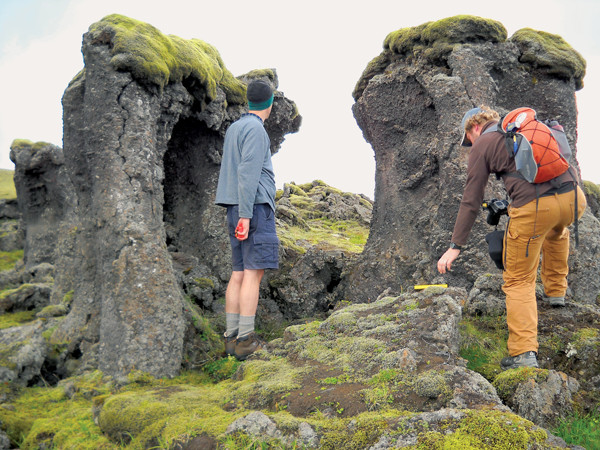
by Timothy Oleson Friday, January 3, 2014

Clusters of moss-covered, two-meter-tall basalt pillars in Iceland's Skaelingar Valley remain from the Laki lava flow of 1783. Tracy Gregg

The exterior of a freestanding individual basalt pillar. Tracy Gregg
Peculiar basalt pillars found in Iceland — attributed in local lore to a pair of angry trolls hurling projectiles at each other — are having their origin story updated. In a rare example of nonexplosive lava-water interactions occurring on land, the hollow pillars likely formed around vertical columns of steam and superheated water venting through lava as it flowed over saturated ground, according to a new study.
The pillars, roughly 40 in all measuring up to about 2.5 meters tall and 1.5 meters wide, are scattered around Skaelingar Valley, where a tributary flows into the Skafta River near Iceland’s southern coast. Upright and mostly intact, some pillars stand on their own while others form conjoined clusters sharing moss-covered basalt roofs. Several of the pillars are broken open, allowing a cross-sectional view of their thick walls and narrow central conduits, tens of centimeters in diameter.
“It’s almost an otherworldly experience to see these things for the first time because they’re just not very common features,” says Tracy Gregg, a volcanologist at the University at Buffalo, who along with graduate student Kenneth Christle documented the pillars in the Journal of Volcanology and Geothermal Research. Gregg, who in the past has observed underwater lava pillars (while aboard the Alvin research submersible) that had formed as molten rock and geothermally heated water spewed from mid-ocean ridges, says that the Skaelingar features are reminiscent of these deep-sea formations.
They are also similar to so-called lava trees found in Hawaii — hollow basalt cylinders that formed when lava flowed through a forest, cooling on contact with tree trunks that were incinerated in the process. “But we know that that’s not what [the pillars] are in Iceland because when this lava flow erupted, there were no trees in Iceland,” Gregg says.
According to Gregg and Christle’s explanation, when the Skafta River Gorge became blocked during the Laki eruption of 1783, the lava that had been flowing from nearby fissures through the gorge began backing up into smaller tributary valleys like the Skaelingar. As lobes of molten rock pushed up the valley, the saturated ground surface heated rapidly. Steam and hot water rising through small gaps between lobes formed geysers, around which the lava that kept pouring past quickly cooled, solidified and gradually thickened. Then, once the blockage in the main gorge broke, the still-molten portion of lava in Skaelingar flowed back down the valley, leaving the hardened pillars and fragments of the crust that had formed on top of the flow in its wake.
The whole process probably occurred over just a few hours to days, and required the right mix of conditions for the pillars to form, Gregg and Christle suggested, noting that they aren’t found in the other nearby valleys flooded by the Laki eruption. If the lava flow had been too thick or moving too fast, steam wouldn’t have been able to escape through it, thus preventing pillars from forming, Gregg says. This may explain why those in the Skaelingar occur around the valley margins, where the Laki flow was probably thinner and moving slower than in the center of the valley, she says, noting a similar trend at mid-ocean ridges where pillars tend to form around the edges of troughs where lava pools.
Additionally, the fact that the pillars are preserved intact indicates that the lava-water interactions were nonexplosive, a rarity in terrestrial volcanic settings. “Normally, when we think of lava coming in contact with water, we think of that water flashing to steam and causing an explosion,” Gregg says. “Here’s an example where … you could’ve stood right there and watched it.”
© 2008-2021. All rights reserved. Any copying, redistribution or retransmission of any of the contents of this service without the expressed written permission of the American Geosciences Institute is expressly prohibited. Click here for all copyright requests.